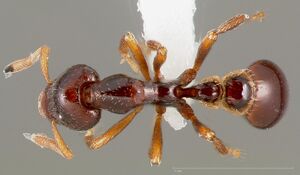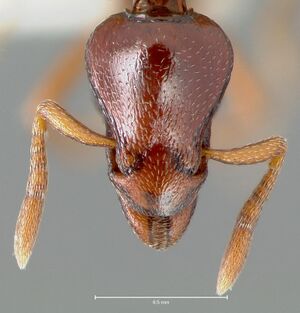Strumigenys exiguaevitae
| Strumigenys exiguaevitae | |
|---|---|

| |
| Scientific classification | |
| Kingdom: | Animalia |
| Phylum: | Arthropoda |
| Class: | Insecta |
| Order: | Hymenoptera |
| Family: | Formicidae |
| Subfamily: | Myrmicinae |
| Tribe: | Attini |
| Genus: | Strumigenys |
| Species: | S. exiguaevitae |
| Binomial name | |
| Strumigenys exiguaevitae Baroni Urbani, 2007 | |
| Synonyms | |
| |
Known from montane and rainforest habitats, samples have been collected in litter samples, a winkler sample, from rotten wood and from under moss on a live tree.
Identification
A member of the exiguaevitae complex in the Strumigenys leptothrix-group.
Bolton (2000) - S. hoplites forms a very close species-pair with Strumigenys serket. The two share most diagnostic characters including the interesting arrangement of 4 hairs in a square shape at the highest point of the vertex. This is paralleled in the Malaysian basicerotine species Eurhopalothrix dubia and Eurhopalothrix platisquama (Taylor, 1990), but has not been seen anywhere else among the dacetines. Separation of hoplites and serket is discussed under the latter name.
The other two species in the complex, Strumigenys hathor and Strumigenys seti, are easily distinguished as the lateral spongiform lobes of the petiole are much less strongly developed and the cephalic dorsum is more densely hairy. In dorsal view the petiolar lateral spongiform lobes are small in seti, vestigial in hathor. At their strongest they are mostly confined to the posterior half of the sides of the node, broadest at its posterolateral corners and petering out anteriorly, not approaching the anterior margin of the node in a broad band as is seen in hoplites and serket. The cephalic dorsum behind the highest point of the vertex in seti and hathor has numerous hairs, not merely the four short hairs set in a square that is characteristic of hoplites and serket.
Keys including this Species
Distribution
Distribution based on Regional Taxon Lists
Malagasy Region: Madagascar (type locality).
Distribution based on AntMaps
Distribution based on AntWeb specimens
Check data from AntWeb
Countries Occupied
| Number of countries occupied by this species based on AntWiki Regional Taxon Lists. In general, fewer countries occupied indicates a narrower range, while more countries indicates a more widespread species. |

|
Estimated Abundance
| Relative abundance based on number of AntMaps records per species (this species within the purple bar). Fewer records (to the left) indicates a less abundant/encountered species while more records (to the right) indicates more abundant/encountered species. |

|
Biology
Castes
Worker
Images from AntWeb
   
| |
| Paratype of Strumigenys exiguaevitae. Worker. Specimen code casent0005453. Photographer April Nobile, uploaded by California Academy of Sciences. | Owned by CAS, San Francisco, CA, USA. |
   
| |
| Holotype of Strumigenys exiguaevitae. Worker. Specimen code casent0005993. Photographer April Nobile, uploaded by California Academy of Sciences. | Owned by NHMUK, London, UK. |
   
| |
| Worker. Specimen code casent0456151. Photographer April Nobile, uploaded by California Academy of Sciences. | Owned by CAS, San Francisco, CA, USA. |
Queen
Images from AntWeb
   
| |
| Paratype of Strumigenys exiguaevitae. Queen (alate/dealate). Specimen code casent0005452. Photographer April Nobile, uploaded by California Academy of Sciences. | Owned by CAS, San Francisco, CA, USA. |
Nomenclature
The following information is derived from Barry Bolton's Online Catalogue of the Ants of the World.
- hoplites. Pyramica hoplites Bolton, 2000: 347, figs. 225, 245 (w.q.) MADAGASCAR. [Junior secondary homonym of hoplites Brown.] Replacement name: exiguaevitae Baroni Urbani, 2007: 119.
- exiguaevitae. Strumigenys exiguaevitae Baroni Urbani, 2007: 119. Replacement name for Pyramica hoplites Bolton, 2000: 347. [Junior secondary homonym of Strumigenys hoplites Brown, 1973c: 266.]
Unless otherwise noted the text for the remainder of this section is reported from the publication that includes the original description.
Description
Worker
Holotype. TL 3.4, HL 0.77, HW 0.56, CI 73, ML 0.14, MI 18, SL 0.38, SI 68, PW 0.36, AL 0.90. Characters of hoplites-complex. Anterior clypeal margin very broadly and evenly convex, the dorsum with minute appressed hairs that are difficult to see, the hairs arranged in longitudinal rows and directed anteriorly or anterolaterally; clypeus without any other form of pilosity. With head in profile the dorsal outline rising posteriorly to a very high, remarkably convex dome that bears a cluster of 4 short stout erect hairs arranged at the corners of a small square. The anterior pair of hairs is just in front of the highest point, the posterior pair just behind it. These are the only standing hairs anywhere on the cephalic dorsum or its lateral margins, which otherwise have only minute appressed hairs similar to those on the clypeus. Side of head with some fine punctate sculpture around the eye, but antennal scrobe above the level of the eye mostly smooth and shining. Eye relatively large, with 5 - 6 ommatidia in the longest row. Pilosity extremely sparse on dorsal surfaces of body: one pair of short erect hairs each on mesonotum, petiole and postpetiole; first gastral tergite without standing hairs (see under paratypes for variation). Middle and hind tibiae and basitarsi with sparse appressed spatulate hairs only. Dorsum of pronotum high, narrowly transversely rounded, the sides so steeply convergent dorsally that they almost form a longitudinal ridge. Mesonotal dorsum sloping steeply posteriorly, the propodeal dorsum on a much lower level than the pronotal dorsum in profile; posterior half of mesonotum and entirety of propodeal dorsum marginate laterally. Propodeal declivity with a broad lamella, only the extreme tips of the propodeal teeth free. With petiole in profile the dorsal surface of the node long and shallowly convex, much longer than the short anterior face. Lateral spongiform lobe of petiole extends forward almost the entire length of the node but terminates before the level of the anterior face. In dorsal view the lateral spongiform lobes of the petiole reach almost to the anterior margin of the node. Ventral spongiform lobes of petiole and postpetiole massively developed. Petiole node in dorsal view longer than broad, but shorter than the postpetiole disc. Disc of postpetiole in dorsal view with its anterolateral angles and sides surrounded by spongiform tissue; along the anterior margin the tissue is more lamellate than spongiform. Dorsum of head weakly superficially shagreenate, the remainder of the body almost or entirely lacking sculpture. Disc of postpetiole smooth and shining, with a few weak longitudinal costulae toward the lateral margins. First gastral tergite with short basigastral costulae.
Paratypes. TL 3.2-3.7, HL 0.74-0.86, HW 0.55-0.62, CI 72-75, ML 0.12-0.15, MI 15-18, SL 0.33-0.40, SI 61-68, PW 0.34-0.40, AL 0.86-0.96 (5 measured). As holotype but sculpture of postpetiole may be almost effaced. Pairs of short erect hairs on body varying as follows: mesonotum 0-1, petiole 0-1, postpetiole 1, first gastral tergite 0-2 (at extreme base); mere loss by abrasion may account for these differences.
Type Material
Holotype worker, Madagascar: 43 km. S Ambalavao, Res. Andringitra, 22°14' S, 47°00'E, 825 m., 9.x.1993, sifted litter (leaf mold, rotten wood), rainforest, #760 (1)-8 (B.L. Fisher) (Museum of Comparative Zoology). Paratypes. Madagascar: 1 worker with same data as holotype but #760 (4)-5; 1 worker with same data but #760 (2)-6; 1 worker with same data but 10.x.1993, ex rotten log, rainforest, #767-1; 2 workers 13 km. NW Enakara, Res. Andohahela, 24°33'S, 46°48'E, 1250 m., 30.xi.1992, sifted litter (leaf mold, rotten wood), montane rainforest, #561 (40)-3 (B. L. Fisher); 1 queen (dealate) with same data as last but #561 (26)-3; 1 queen (dealate) 45 km. S Ambalavao, 22°13'S, 47°01'E, 758 m., 25.ix.1993, #696 (34)-5 (B.L. Fisher) (University of California, Davis, The Natural History Museum).
References
- Baroni Urbani, C. & De Andrade, M.L. 2007. The ant tribe Dacetini: limits and constituent genera, with descriptions of new species. Annali del Museo Civico di Storia Naturale “G. Doria” 99: 1-191
- Bolton, B. 2000. The ant tribe Dacetini. Memoirs of the American Entomological Institute. 65:1-1028.
References based on Global Ant Biodiversity Informatics
- Bolton, B. 2000. The Ant Tribe Dacetini. Memoirs of the American Entomological Institute 65
- Fisher B. L. 2003. Formicidae, ants. Pp. 811-819 in: Goodman, S. M.; Benstead, J. P. (eds.) 2003. The natural history of Madagascar. Chicago: University of Chicago Press, xxi + 1709 pp.

